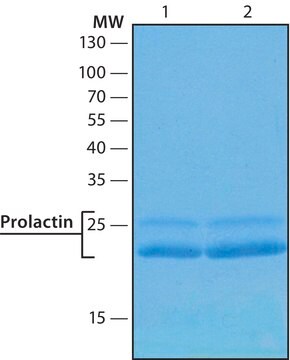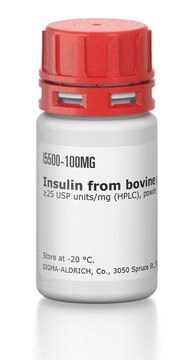L4021
Prolactin human
recombinant, expressed in E. coli, lyophilized powder, BioReagent, suitable for cell culture, >97% (SDS-PAGE)
Sinónimos:
hPRL, LTH, Lactogenic Hormone, Luteotropic Hormone, PRL
About This Item
Productos recomendados
recombinant
expressed in E. coli
Quality Level
description
200 amino acid residue methionyl form of mature, recombinant human prolactin (amino acid residues 29-227).
product line
BioReagent
assay
>97% (SDS-PAGE)
form
lyophilized powder
potency
0.030-0.300 ng/mL EC50
mol wt
predicted mol wt ~24 kDa
technique(s)
cell culture | mammalian: suitable
impurities
endotoxin, tested
solubility
water: 0.5000 mL, clear, colorless
UniProt accession no.
shipped in
ambient
storage temp.
−20°C
Gene Information
human ... PRL(5617)
Application
Biochem/physiol Actions
Other Notes
Physical form
Reconstitution
Analysis Note
signalword
Danger
hcodes
pcodes
Hazard Classifications
Repr. 1B
Storage Class
6.1C - Combustible acute toxic Cat.3 / toxic compounds or compounds which causing chronic effects
wgk_germany
WGK 3
flash_point_f
Not applicable
flash_point_c
Not applicable
Certificados de análisis (COA)
Busque Certificados de análisis (COA) introduciendo el número de lote del producto. Los números de lote se encuentran en la etiqueta del producto después de las palabras «Lot» o «Batch»
¿Ya tiene este producto?
Encuentre la documentación para los productos que ha comprado recientemente en la Biblioteca de documentos.
Los clientes también vieron
Nuestro equipo de científicos tiene experiencia en todas las áreas de investigación: Ciencias de la vida, Ciencia de los materiales, Síntesis química, Cromatografía, Analítica y muchas otras.
Póngase en contacto con el Servicio técnico









